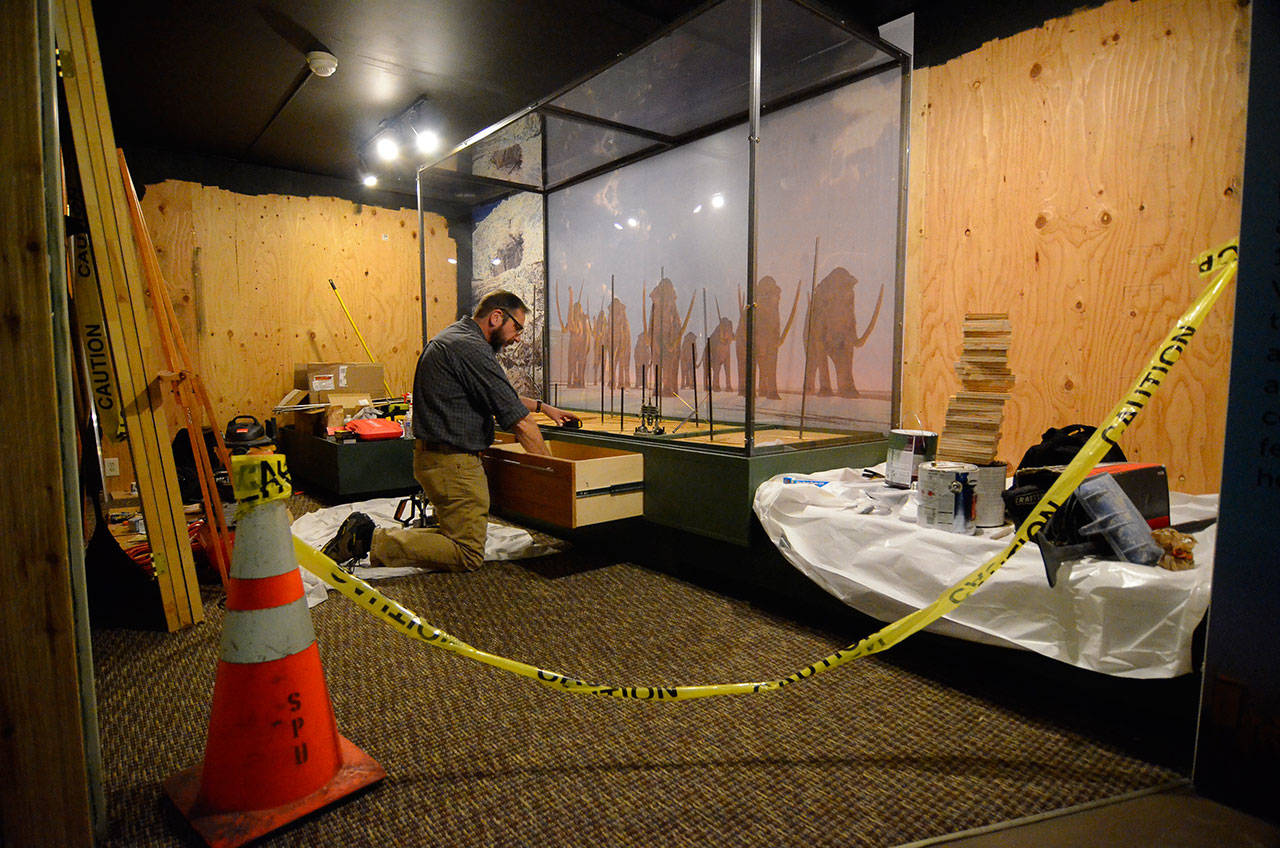About 1,200 centuries ago, Whidbey was part of a broad alluvial plain covered with oak, Douglas fir and was perhaps a few degrees warmer than it is today. Fast forward to about 180 centuries ago, and it was covered by a glacier that soared more than one-half mile high. And about 120 centuries ago, the time when humans may have first arrived — mammoth hunters — it was still about 6,000 years away from being the island it is today.
Long story short, Whidbey has a big history, one that far exceeds the two-century period of white settlement for which it is so often defined.
“It’s more than just little towns,” said Rick Castellano, executive director of the Island County Historical Society. “The history here is so deep.”
Telling that tale is the goal of a new exhibit set to be unveiled at the society’s museum in Coupeville sometime before summer. The Ice Age: 120,000 years of history, all packed into a small 200-square-foot space in the building’s basement.
It won’t be an easy task, Castellano said.
The exhibit aims to communicate a 120-millenia period of pre-history. It’s complicated stuff, particularly the more recent years where Whidbey and Camano were shaped by glaciation. It only takes about 30 seconds speaking with South Whidbey geologist Terry Swanson to become hopelessly lost in the science of what happened: till deposits, elastic rebound, the rise and fall of sea levels, retreating glaciers stopped by shallow water deposits and why that matters, old rocks compared to new rocks and what they mean — there’s a reason why the museum asked Swanson, a principal lecturer at the University of Washington Department of Geology, to consult on the exhibit.
While glaciation has been happening for millions of years, there have been two or three cycles relevant to Washington over the past 200,000 years. This period, known as the late Pleistocene, concluded approximately 12,000 years ago with the end of the Ice Age. It was about 17,000 years ago, however, that began significant shaping of the Whidbey and Camano islands. Over a period of about 4,000 years, a massive lobe of ice advanced and retreated over the region, and it was this back and forth movement that enhanced the pre-existing tectonic structure that makes up the Puget Lowland, or Puget Sound.
Some of the geochronology of this cycle is hidden in plain sight; the chapters are written in visible sediment layers in bluffs all over Whidbey. Fossil Beach in Penn Cove is particularly instructive, said Swanson, and has challenged his understanding of history, the movements of the Puget lobe, when and how.
Some pretty cool things happened during these periods of creation, especially at the end. The islands were well on their way to resembling their current shape and form with some key differences. For one, sea level rise was at a peak, reaching about 140 feet higher in Langley and 200 feet in Coupeville than today. It’s partially the result of melt water feeding the world’s oceans, but locally because the weight of glaciers was so great it actually pushed down the surface of the earth.
“There’s parts of Coupeville that would have been underwater,” he said.
At its peak, the glacier over Whidbey was about 3,800 feet high, Swanson said. To put that into perspective, the Space Needle tops out at 605 feet.
The depressed earth recovered through a process described as elastic rebound, eventually reaching an equilibrium with rising sea levels to establish today’s basic shoreline about 5,000 years ago. By that point, humans may already have been here for thousands of years, and the mammoths long gone, according to Castellano.
Perhaps the best evidence of human’s arrival on Whidbey was the discovery years ago of a type of stone-tool technology known as “Clovis.” The early techniques used to create these points are signatures of a very specific time period, about 10,000 to 12,000 years ago. Archaeologists generally believe they are the earliest type of stone tools found in North and South America, representing an approximate marker for the arrival of humans to the new world.
Several were found years ago “not far” from Coupeville and are believed to be authentic. Though they are not in the museum’s collection, island flint knappers Jim Smith and Joe Higgins have created reproductions for the exhibit.
Other evidence of human arrival to Island County in the neighborhood of 11,000 years ago is in the form of mammoth bones; they’ve been found split in a way that suggest human activity, along with marks that may have come from stone tools and butchering. Also, the oldest middens found on Whidbey largely contain the remains of mammals, rather than the sea life that made up the bulk of diets centuries later and laid the foundation of a nearly common term in Western Washington.
“That’s why we call them ‘shell’ middens,” Castellano said.
Mammoth bones, which are already on display at the museum, will make up a large portion of the new exhibit. They will supplement large graphics and information panels explaining glaciation, along with sound effects and stone tools in pull out displays.
Castellano said he’s hopeful the new exhibit will lead viewers to a better understanding and appreciation of how Whidbey and Camano were formed, and broaden the public’s perception of area history.



